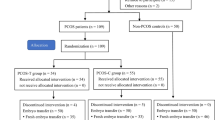Abstract
Purpose
Polycystic ovary syndrome (PCOS) is associated with oxidative stress (OS) and serum superoxide dismutase (SOD) activity has been reported with mixed results. The objective of this study was to examine the activity of SOD both in the serum and FF from women with PCOS undergoing ICSI, as well as the expression of Cu/Zn-SOD mRNA in the cells recovered from the FF.
Methods
Forty women undergoing an ICSI trial were divided into: group I, included 20 PCOS cases, group II included 20 age-matched controls with tubal factor infertility. Both groups were similarly stimulated. A total of 204 metaphase II (MII) oocytes were aspirated; (108) from PCOS, and (96) from the control group. SOD activities in the serum and FF, as well as Cu/Zn-SOD (SOD1) mRNAs in follicular fluid (FF) cells were analyzed.
Results
There was a statistically highly significant decrease (p < 0.001) both in the mean serum SOD (45.56 ± 18.06) and FF SOD activity (42.49 ± 11.46) in PCOS than the control group (77.38 ± 7.82), (74.37 ± 6.15) respectively. The mean relative levels of Cu, Zn SOD mRNAs was significantly lower (p < 0.001) in cells isolated from the FF in PCOS (0.36 ± 0.14) than the control group (0.81 ± 0.15). SOD activity in FF had no effects on fertilization rate (p > 0.05), or embryo quality after intracytoplasmic sperm injection (ICSI).
Conclusion
Although decreased SOD activity in FF has no effect on fertilization rate and/or embryo quality, serum SOD activity could be a clinical parameter for determining systemic oxidative stress in PCOS.

Similar content being viewed by others
References
Kuscu NK, Var A. Oxidative stress but not endothelial dysfunction exists in non-obese, young group of patients with polycystic ovary syndrome. Acta Obstet Gynecol Scand. 2009;88(5):612–7.
Sabuncu T, Vural H, Harma M, Harma M. Oxidative stress in polycystic ovary syndrome and its contribution to the risk of cardiovascular disease. Clin Biochem. 2001;34(5):407–13.
Faraci FM, Didion SP. Vascular protection: superoxide dismutase isoforms in the vessel wall. Arterioscler Thromb Vasc Biol. 2004;24(8):1367–73.
Sabatini L, Wilson C, Lower A, Al-Shawaf T, Grudzinskas JG. Superoxide dismutase activity in human follicular fluid after controlled ovarian hyperstimulation in women undergoing in vitro fertilization. Fertil Steril. 1999;72(6):1027–34.
Verit FF, Erel O. Oxidative stress in nonobese women with polycystic ovary syndrome: correlations with endocrine and screening parameters. Gynecol Obstet Invest. 2008;65(4):233–9.
Jana SK, Babu NK, Chattopadhyay R, Chakravarty B, Chaudhury K. Upper control limit of reactive oxygen species in follicular fluid beyond which viable embryo formation is not favorable. Reprod Toxicol. 2010;29(4):447–51.
Lee Y, Chin-Kun BL, Sajal G, Nabil N, Ashok A. Role of oxidative stress in polycystic ovary syndrome. Curr Women’s Health Rev. 2010;6(2):96–107.
Nishikimi M, Roa NA, Yogi K. The occurrence of superoxide anion in the reaction of reduced phenazine methosulfate and molecular oxygen. Biochem Biophys Res Commun. 1972;46:849–54.
Raha S, Ling M, Merante F. Extraction of total RNA from tissues and cultured cells. In: Rapley R, Walker JM, editors. Molecular biomethods handbook. Humana Press Inc., Totowa, NJ. Ch. 1; 1998. p. 1–8.
McPherson MJ, Moller SG. Analysis of gene expression. In: McPherson MJ, Moller SG, editors. PCR. BIOS Scientific Publishers Ltd, Oxford. Ch. 8; 2000. p. 183–211.
Sogino N, Takiguchi S, Kaschida S, Karube A, Nakamura Y, Kato H. Superoxide dismutase expression in the human corpus luteum during the menstrual cycle and in early pregnancy. Mol Hum Reprod. 2000;6(1):19–25.
Zhang D, Luo WY, Liao H, Wang CF, Sun Y. The effects of oxidative stress to PCOS. Sichuan Da Xue Xue Bao Yi Xue Ban. 2008;39(3):421–3.
Rajendran S, Willoughby SR, Chan WP, Liberts EA, Heresztyn T, Saha M, et al. Polycystic ovary syndrome is associated with severe platelet and endothelial dysfunction in both obese and lean subjects. Atherosclerosis. 2009;204(2):509–14.
Gonzalez F, Rote NS, Minium J, Kirwan JP. Reactive oxygen species induced oxidative stress in the development of insulin resistance and hyperandrogenismin polycystic ovary syndrome. J Clin Endocrinol Metab. 2006;91(1):336–40.
Bausenwein J, Serke H, Eberle K, Hirrlinger J, Jogschies J, Abu Hmeidan F, et al. Elevated levels of oxidized low-density lipoprotein and of catalase activity in follicular fluid of obese women. Mol Hum Reprod. 2010;16(2):117–24.
Wiener-Megnazi Z, Vardi L, Lissak A, Shnizer S, Zeev Reznick A, Ishai D, et al. Oxidative stress indices in follicular fluid as measured by the thermochemiluminescence assay correlate with outcome parameters in in vitro fertilization. Fertil Steril. 2004;82 Suppl 3:1171–6.
Behrman HR, Kodaman PH, Preston SL, Gao S. Oxidative stress and the ovary. J Soc Gynecol Investig. 2001;8 Suppl 1:S40–2.
Carbone MC, Tatone C, Delle Monache S, Marci R, Caserta D, Colonna R, et al. Antioxidant enzymatic defences in human follicular fluid: characterization and age-dependent changes. Mol Hum Reprod. 2003;9(11):639–43.
Centurione L, Giampietro F, Sancilio S, Piccirilli M, Artese L, Tiboni GM, et al. Morphometric and ultrastructural analysis of human granulosa cells after gonadotrophin-releasing hormone agonist or antagonist. Reprod BioMed Online. 2010;20(5):625–33.
Carbone MC, Tatone M, Monache SD, et al. Antioxidant enzymatic defences in human follicular fluid: characterization and age‐dependent changes MHR: basic science of reprod. Medicine. 2003;9(11):639–43.
Matos L, Stevenson D, Gomes F, Silva-Carvalho JL, Almeida H. Superoxide dismutase expression in human cumulus oophorus cells. Mol Hum Reprod. 2009;15(7):411–9.
Combelles CMH, Holick AE, Paolella JL, Walker CD, Wu Q. Profiling of superoxide dismutase isoenzymes in compartments of the developing bovine antral follicles. Reproduction. 2010;139:871–81.
Author information
Authors and Affiliations
Corresponding author
Additional information
Capsule Serum superoxide dismutase (SOD) activity could be a clinical parameter for determining systemic oxidative stress in PCOS.
Rights and permissions
About this article
Cite this article
Seleem, A.K., El Refaeey, A.A., Shaalan, D. et al. Superoxide dismutase in polycystic ovary syndrome patients undergoing intracytoplasmic sperm injection. J Assist Reprod Genet 31, 499–504 (2014). https://doi.org/10.1007/s10815-014-0190-7
Received:
Accepted:
Published:
Issue Date:
DOI: https://doi.org/10.1007/s10815-014-0190-7



